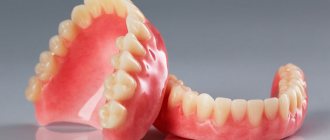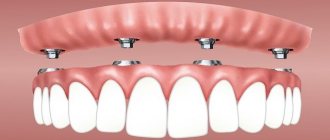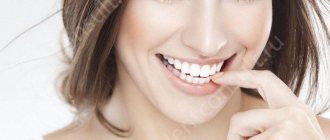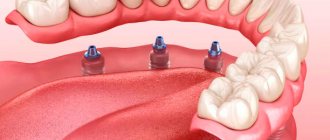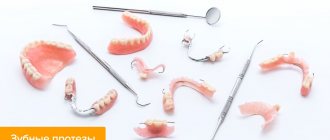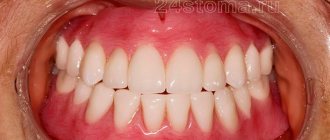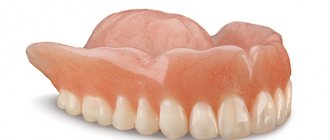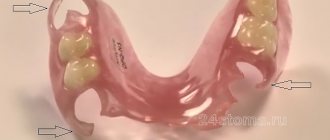Artificial jaws: types
First of all, let's define the terminology to make the following text easier to understand.
- Basis - the base, which looks very similar to the gum, fits tightly to the oral cavity. The borders are made of modern polymer materials.
- Fastening – various locks with hooks securing the entire structure to supporting healthy organs.
- Implants are elements firmly embedded in the base, replacing individual chewing units. In production, light components are used that are as close in color to real teeth as possible.
Classification by type
Types are divided according to the substances contained in the composition. However, a distinction based on how partial dentures are placed, how they are inserted and secured, and what the dentures look like is the most correct approach.
Lamellar
The most inexpensive and accessible way to restore chewing functions. The plastic base completely covers the curves in the patient’s mouth and the contours of the gums. They are attached to supporting intact masticatory organs. Acrylic, nylon, and other modern materials that prevent allergic reactions are used in the production of these implants.
Low cost with simple fixation are the main advantages. The age group of patients for their use is not limited. However, the restoration of chewing functions does not occur completely; diction may be impaired, and the structure does not hold well in the mouth. The photo shows the installation of removable plate and one-sided dentures on hooks.
Clasp
Artificial analogues are attached to a metal frame. Since the base is made of durable material, the product will last quite a long time. Installed using various hooks, crowns and other methods.
This type of substitution is not suitable for those who have allergic reactions to the main component. High cost is also a significant disadvantage. Among the positive features are strength, strong fixation, complete restoration, natural appearance.
Immediates
They cannot be considered a permanent solution, as they are temporary measures. The installation of partially removable dentures is shown in the photo.
For a short period of time they can completely restore all aesthetic and chewing functions. But, it should be remembered that their use is only possible when one or two damaged units are restored.
Low cost along with quick installation are positive aspects. Soft components make the implant unstable to heavy loads and greatly reduce its service life. The use of immediates is common in dental practice when it is necessary to prevent the displacement of remaining teeth towards the removed ones.
Modular
Separately, I would like to consider modular and non-modular models. A module is a special system in which hinges are installed into the device to perform the functions of a joint. In simpler models, shock absorption and movement occur using a spring, and in complex models, using a microprocessor. Thus, bionic prostheses are a type of modular ones.
Depending on the type of device, it may contain one, two or three modules. So the device, which replaces the entire leg, has three modules. Such models greatly simplify life, because they perform not only a supporting function, but also the functions of joints, that is, they allow you to bend your leg, move quickly and even go down the stairs normally.
Prostheses without a module are simple models that perform a supporting function. With such a device, a person can move on a flat surface, but all the functions of the joint are absent. Simpler models are suitable for people who move little, mainly the elderly. Young and active patients require modular devices.
How to make a denture, a completely artificial false jaw: materials
The components that form the basis of such products determine the quality of human life. Good and durable, anti-allergenic, do not cause discomfort, are installed painlessly, quickly and easily. The main thing is that there is no rejection.
Prostheses from the low price segment are often manufactured in a short time. However, they do not tolerate heavy loads well, do not last long, and can cause unpleasant sensations: itching, irritation of the oral cavity.
Plastic
Affordable and widespread chemical material. It is used in all spheres of human life: from domestic needs to medical. It gained popularity due to its efficiency and easy processing.
Low cost greatly influenced its development in dentistry. The affordable price is perhaps its only advantage in this area. Simple installation, fastening of partially removable and fully overlay plate dentures with the palate has the following reviews:
- fall out;
- ugly appearance;
- cause severe discomfort while eating due to unevenly distributed load.
Particularly weak attachment in the lower jaw area. The sublingual space is uneven, so it is impossible to attach a classic suction cup to it. The problem is solved as follows:
- use special creams for retention;
- installation of the lower chewing part is carried out on living units.
Orthopedic products are held in place by clasps, which grip the implant at the base and give the structure the necessary rigidity. The most popular are removable dentures ivocap with the following pros and cons.
Positive traits:
- the upper jaw has good stability;
- low cost;
- common;
- suitable for repair;
- ease of construction;
- unpretentious in care.
Negative sides:
- a large frame takes up a lot of space in the mouth;
- clasps are noticeable with close eye contact;
- the lower part is poorly fixed;
- the alveolar arch and process gradually atrophy;
- short-lived.
Recommended as a temporary solution, or for complete/partial edentia.
Made from acrylic
The most inexpensive and widespread prostheses, which are based on polymer masses of low cost and quality. Among all lamellar ones, they are able to provide acceptable aesthetics. They are highly allergenic, fall out, break and cause discomfort.
Acry-free
Removable dentures or dentures made from an improved polymer relieve its owner from possible irritation of the oral cavity, are more durable, and reduce the risk of breakage.
An excellent option for temporary solutions while a high-quality and durable replacement is manufactured. People with hypersensitivity can easily wear them until full implants are inserted.
Spofadent
The base is made of three-layer plastic. They are characterized by durability, strength, resistance to chemical compounds, and visual appeal.
The design is loved by dentists and clients for its beautiful appearance. A colored complete removable denture is an analogue of living tissue.
IvoBase
Polymethyl methacrylate is an organic plastic that has innovative properties thanks to a unique creation method (the polymer is mixed in an injection device):
- greatly reduces the risk of an allergic reaction;
- prevents hypersensitivity;
- eliminates errors (low bite, large shrinkage).
Automation follows the entire technological process exactly. As a result, porosity decreases and strength increases. These properties ensure the durability of the entire system.
Vertext
Modern and thermoplastic, eliminates the use of monomer. Dryness, burning, allergic reactions are completely absent. The material is much stronger than analogues. Consequently, the basis is very thin. In turn, it increases the sensitivity of taste buds and articulation.
DeFlex
An Argentine company has made a breakthrough in dentistry by developing a polyamide that ensures complete transparency of the entire frame, including clasps. Transmitting light, it completely merges with the tissues of the oral cavity.
Widely used by athletes, police officers, and emergency services to provide jaw protection.
Nylon
The base is filled with soft nylon. 100% transparency ensures complete fusion with the mucous membrane. Clasps are made of the same material.
The patient quickly gets used to the foreign body in the mouth. High elasticity reduces stress on gums and soft tissues. The sufficient strength of the material used makes it possible to minimize the frame in order to maintain diction.
However, the pros turn out to be cons. To answer the described contradiction, it is important to understand the following question: how is a full-fledged nylon denture installed?
The thin and elastic component located at the base requires a mesh structure. When chewing hard food, fibers dig into the palate or gums, causing pain.
Advantages:
- quick addiction;
- 100% camouflage;
- biocompatibility.
Flaws:
- frequent hair loss requires you to always use fixing creams and ointments;
- chewing function – weak;
- expensive;
- lead to accumulation of plaque on the rough part;
- require adherence to a strict diet;
- the alveolar ridge bears the entire load.
Indications for use:
- partial edentia with preservation of supporting organs;
- in cases where aesthetics comes to the fore;
- The patient is allergic to acrylic.
So, we figured out how false jaws are made, the pros and cons of dental prostheses and various components. Let's move on to indications for the use of other types.
Prices for upper jaw prosthetics
| Consultation with an orthopedic doctor | For free |
| Cast | From 740 ₽ |
| Bite modeling | 2 500 ₽ |
| Removable prosthetics | 20 450 ₽ |
| Immediate prosthesis | 12 800 ₽ |
| Acry-Free prosthetics | from 55,000 ₽ |
| Nylon prosthesis | 27 400 ₽ |
| Clasp prosthesis | 52 000 ₽ |
Expert of the article you are reading: Natalich Boris Anatolyevich Chief physician, CMN, doctor of the highest category, orthopedist, surgeon, implantologist, leading specialist of the NovaDent network
37 years
Clinical experience
Otradnoe
st. Khachaturyan, 7
+7 +7
Free consultation with this specialist
Immediate
Replace a unilateral included defect. The design can be created from any materials used in dentistry. Capable of restoring a row of holes. Also found under the name "butterflies".
Several artificial crowns are attached to a miniature base, secured with hooks and locks. Recommended as a temporary solution after removal of diseased masticatory organs.
For those who are going to install metal ceramics and do not have enough money, it helps to gain time to collect them. Some patients use it all their lives, replacing it with a new one after a few years.
When the leg came off completely on New Year's Day
By the second or third day of January, many of us wake up and experience similar and familiar emotions and questions: Where am I? What is the year now? Why does my head split like that? Where did January 1st go? In my case, in addition to the above questions, I soon have an equally important question: “Where is my leg?” Don't be alarmed, this is not a plot from some horror story. Now, of course, we are not talking about my real leg (I said goodbye to it two years ago), but about the prosthesis, which most of the time, to the best of its ability, now plays the role of an artificial limb of my right limb.
As I had to adjust to my new one-legged life, one of the things that soon became part of my bedtime routine was remembering where I left my “leg.” More precisely, I quickly realized that it is advisable not to throw the prosthesis and crutches anywhere in the apartment, but to get into the habit of placing them near the bed (and, more recently, not to forget to connect the “leg” to recharge). When you wake up in the middle of the night out of “need” or in the event of, God forbid, some kind of emergency (a fire, a flood, or an unexpected doorbell from neighbors), it is very important to be mobile and ready as soon as possible. Jumping around the apartment in the dark in search of crutches or a prosthesis is an extreme activity that it is advisable to avoid.
In most cases, there are no problems with the location and search of the prosthesis. But on those rare holidays when I’ve had a little too much with friends, that moment of panic comes from a hangover when I can’t immediately find and remember where I left my “leg.” Considering the cost of the device and the pain that had to go through in order to adjust it for comfortable use, the fear comes to me that “drunken” I could lose it or leave it somewhere. At those moments, various Gogolian fantasies come to my mind that the leg has escaped and is currently wandering around the city, made documents for itself, got a job, and (considering its elite status) on weekends has a blast with the fair sex in fashionable clubs.
Conditionally removable
Anyone who has ever gone to the dentist for dentures is concerned about how to make them, who makes and inserts dentures on hooks, what methods of fastening exist, and what they look like on the teeth.
The design received its name due to special fixation methods. Special crowns and clasps ensure a secure fit in the mouth. They will never fly out on their own. You can remove it using special skills (usually a dentist does this).
Clasp
This type of implant is described above. Additionally, 3 types of structures should be distinguished:
- Clammers. The metal claw mount provides a secure fit and poor aesthetics.
- Lock. Divided into two parts: the first on the side, the second on the inside. Installation of such a connection requires grinding of adjacent elements.
- Telescopic. The inner crown is made of solid metal, onto which an outer structure (for example, ceramic) is placed.
Indications for use:
- edentia, in which at least 5 teeth are preserved;
- more than three units in a row are missing;
- mobile teeth (loose);
- other implants cannot be installed.
Quadrotti
Clasp or clasp without metal. Biocompatible plastic is at the core of the entire design.
Positive traits:
- there is no need to grind the supporting parts;
- the material does not cause allergies;
- cheap;
- the patient gets used to it easily;
- the chewing load is distributed correctly.
Negative qualities:
- despite greater stability compared to fully removable ones, the fixation is weak;
- the classic arc has high strength;
- service life is 3-4 years.
How a new generation of complete removable dentures are attached without a palate and what they are like
It is based on two materials:
- hard acrylic for bases and implants;
- soft polyurethane for fasteners.
At the base of the mechanism is an imitation of gum, which ensures a strong fixation. Dentists are still arguing about what type they should be: completely removable or not.
Manufacturing
As a rule, manufacturers offer two options for making a prosthesis. The patient can order the device individually, and it will be manufactured within 3-4 weeks, or purchase a ready-made model at an orthopedic store. More complex modular prostheses are usually made only to order, while dummies and simple devices can be purchased in a store or received free of charge under a compulsory medical insurance policy in Russia.
Regardless of the type, all prosthetic legs include a socket that is placed directly on the prepared stump. A prosthetic leg includes a foot, modular elements that perform the function of a joint, and other auxiliary elements.
The sleeve is made of soft materials so that the patient can use the device comfortably. The modules are usually metal because they must withstand weight and serve a person for a long time. The foot is usually made of latex and closely resembles the real human foot.
Modern models are quite complex, so they take quite a long time to make, on average one month. But it’s worth it, because the person again gains the ability to move normally, becomes self-confident and continues to live a normal life.
What to choose if you are completely missing teeth
If the doctor has not identified any contraindications, separate implants are recommended. However, you can look towards removable or partially removable options.
Partial absence
Conducive to installing butterflies and crowns. Any of the methods described in the article is suitable for replacing a bite. Only a qualified specialist can provide the correct advice in each specific case.
For the upper and lower parts of the mouth
If we are talking about removable structures, plate options can be used at the top, and fixed ones at the bottom. This advice is based on the anatomical features of the jaw. However, only the doctor will provide the correct solution.
Homemade prosthesis for a friend (19 photos)
Photo report about how a small group of friends made a homemade lightweight prosthesis for their friend. Even professionals can envy this result.
As a result of life's troubles and the incompetence of domestic medicine, one of our acquaintances became disabled, namely, he was left without an arm. Since a “normal prosthesis” can be looked after 1.5-2 months after the operation, and our friend’s work is closely related to appearing in public, it was decided to help our friend and make a temporary super-light prosthesis for him.
As a basis, sheet construction foam was chosen, which was sawed into 2 parts and glued with polyurethane foam, we adjusted the blank
this piece went to hand
an aluminum bolt of 15 cm was found to accommodate the “arm” and hand
I had to sharpen it a little to get it to fit and tighten. Since the brush fastener did not quite fit our bolt
using wide elastic bands we make a flexible elbow joint
tape for strength
From the elbow pads of the roller protection and a pair of bolts we make a movable and soft shoulder fastener so that it does not press or rub
we flare it so that it doesn’t unwind and our friend’s arm doesn’t fall off somewhere in a business center or at work
for better contact with clothing, we pulled a thick medical stocking over the prosthesis
the client is happy!)) total: costs 300 rubles for a brush.
Source
Service life and care
Durability depends on materials, quality of installation and maintenance. The following tips will help you make it last as long as possible:
- every 6 months it is necessary to visit a doctor to assess the condition - especially when using rigid structures;
- 2 times a day you need to treat the oral cavity and removable jaws with a solution or rinse with clean water;
- follow individual recommendations received from your doctor.
The article answered the questions: what is a complete and partially removable denture, what types are there in dentistry, which are better, what the price depends on. It should be noted that the text is not a guide to action; its main purpose is to introduce the reader to the varieties. If you have any questions or pain, please contact your dentist.
Choice
You need to choose a prosthesis together with your attending physician - an orthopedic surgeon; he will help you select a model and prepare the stump so that the rehabilitation is as comfortable as possible and there are no problems with movement in the future. We have selected several popular models of prostheses:
You can get a prosthetic leg completely free of charge under your compulsory medical insurance policy, but, unfortunately, the procedure is not as simple as we would like. After the procedure, a person will have to contact several government departments, receive a disability and a referral.
Often the waiting period for a prosthesis is prolonged; in addition, it is very difficult for a patient with an amputated limb to collect certificates on their own, and the stump must be formed immediately and the device must be put on as soon as possible. For this reason, many patients decide to purchase the device themselves, but in this case, compensation for part of the funds is possible.
Insurance usually provides the simplest prostheses that provide support when walking. Unfortunately, it is not possible to receive an expensive bionic prosthesis for free, since such a service is not included in the list.
The cost of conventional leg prostheses ranges from 150-180 thousand rubles. Bionic prostheses and models with an external source are inaccessible to ordinary people; the price of such devices varies from 1.5 to 2.5 million rubles. It is worth noting that installing a prosthesis in Russia is much cheaper than abroad.
The quality of life with a prosthesis depends not only on the device itself, on its correct installation, but also on further care. To make wearing the product safe and comfortable, you must properly care for the stump and the prosthesis itself, following the rules described below. Recommendations for stump care:
Recommendations for caring for the prosthesis:
When using bionic prostheses, be sure to read the instructions and follow the operating rules. If the prosthesis does not have a moisture-proof coating, it should not be wetted, otherwise it will quickly fail.
Source
How can I make it easier for myself to adapt and get used to a lower removable denture?
If the denture is very poorly fixed on the jaw and dangles, if the jaw is flat and there is nothing for the denture to grab onto, then you can use special means to improve the fixation of the removable denture. These are various adhesives and gaskets.
Many patients do not wear their dentures all the time, and they especially often take them out at night. There is no such need; to get used to it, it is better to wear the prosthesis around the clock. Nothing bad can happen at night, the prosthesis simply cannot be swallowed or choked on, it is much larger than a person’s throat. In the worst case scenario, you may wake up and the denture is not in your mouth, but lying next to you on the pillow. You shouldn’t take breaks during the day either, even if your jaw and gums are tired, you want to rest. At this moment, when you remove the prosthesis, the jaw and mucous membranes become unaccustomed to the prosthesis, and when an hour later you put it on again, everything starts all over again. At the same time, the jaw and mucous membranes become even more tired. Often, patients who take breaks simply stop wearing such a prosthesis after a few days.

